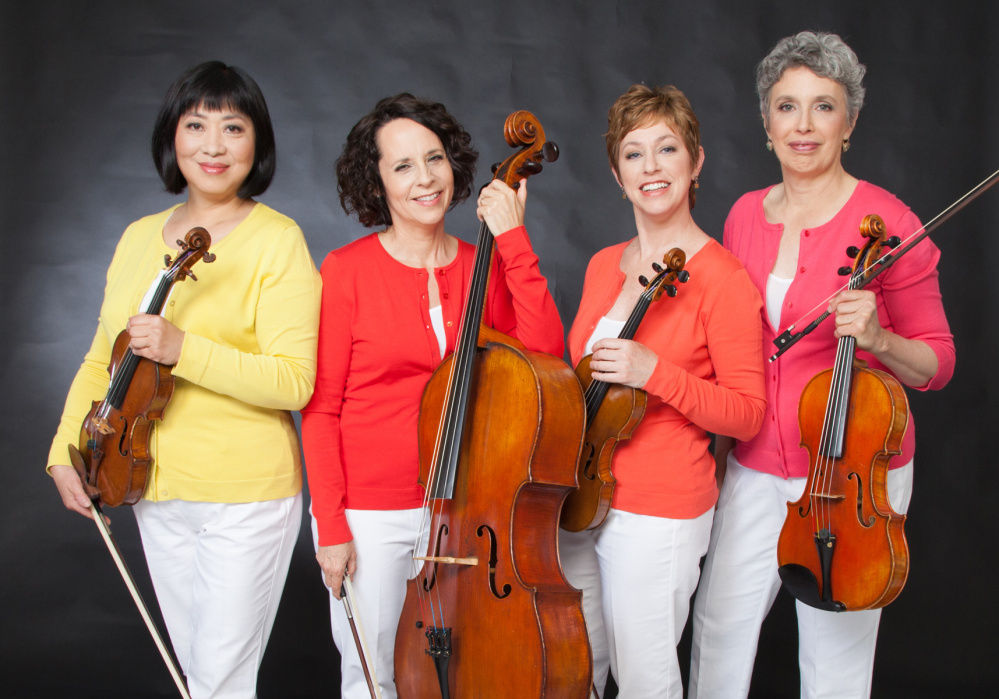The Seal Bay Festival, now in its 14th season, began last week with a pair of concerts at Colby College in Waterville and made its way to Vinalhaven and Belfast before arriving in Portland for a concluding round of performances that included a stop at SPACE Gallery on Thursday evening. The festival’s resident ensemble is the Cassatt String Quartet, a group unusually devoted to contemporary music, and its programs are almost entirely built of works by the festival’s resident composers.
But the festival is not just about performance. There is an associated Composer Institute, at which the resident composers coach younger colleagues. And because the Cassatt is named for the painter Mary Cassatt, art is a component, as well. As part of their training, the students worked with artist and critic Rebecca Allan, who had them get in touch with their internal Picassos by drawing and painting, something Allan and a few of the student composers explained in a pre-concert talk in the gallery next door to SPACE’s concert room.
At SPACE, the Cassatt played works by Chris Rogerson, Hannah Lash, Laura Kaminsky and Dan Visconti, who share an eclecticism that makes their music accessible but difficult to label easily. All draw freely on modernist dissonances and occasional harshness, used expressively and often pictorially. But they are also given to stretches of neo-Romantic consonance, and a structural clarity that, in some cases, gives the music a narrative arch.
Rogerson’s three-movement String Quartet No. 2 (2013) certainly embraced a narrative sensibility. It was inspired by Stephen Dunn’s poem, “Sweetness,” a pained reflection on loss and grieving. The opening movement quickly establishes the work’s melancholy cast by drawing on the same tart but inviting harmonic world that drives Samuel Barber’s early scores, but having set the tone, Rogerson evokes the shifting mood of Dunn’s poem – a balance of bitterness, acceptance, puzzlement and gratitude – by tweaking the music’s levels of tension and relief.
A lighter but harmonically tougher dance piece moves away from the dourness of the opening movement, juxtaposing touches of mechanistic, quasi-Minimalist figuration with slides and pizzicato passages, as well as soaring, plangent violin themes. But the dark mood is never dispelled fully. In his finale, Rogerson presents a chorale, built of emotionally charged chordal writing of strikingly eloquent simplicity.
Lash’s “PULSE-SPACE” (2014) was written with the expectation that it would be choreographed, and though that hasn’t happened (yet), its impulse toward movement is clear enough. Lash begins with vehemently bowed dissonant chords, bound with a unity of purpose that gradually fragments as the four instruments pull away from each other. Still, this drift is tightly circumscribed, and although there is an ebb and flow in the music’s dynamics and harmonic density, the score never loses its edginess and drive.
Kaminsky’s “Rising Tide” (2012 ) was commissioned as part of an ecological project that brought together scientists and artists to look at the effects of climate change. It is meant to be performed with projected art works by Rebecca Allan, and those might have made the ecological element clearer than the music alone can. Still, the four-movement score has an evocative power of its own.
Its opening movement, “Source of Life (H2O)” begins with a throaty, cantorial viola line and expands to a fuller, brighter, slightly acidic texture that offers touches of painterly grandeur while avoiding references to past composers’ evocations of water. The movements that follow – the eerily quiet “Bios,” the brisk, multilayered “Forage” and the lush, melancholy “Societas” – range farther afield, and if they did not necessarily evoke images of melting polar ice caps, they suggested the drama of a world being irrevocably transformed, which may be more to the point.
Visconti’s “Black Bend” (2003) closed the concert on a lighter note. A short work, running about five minutes, the piece is inspired by a turn in the Cuyahoga River, in Ohio, that local lore holds to be haunted. Visconti paints the scene vividly, with a hazy opening, harsh violin attacks and pizzicato cello figures. But he quickly steers it into another realm. Like his “Lonesome Road,” which was heard here last summer at the Portland Chamber Music Festival, “Black Bend” melds modernist techniques and elements of popular music, in this case, the blues, with the violins contributing the string bending effects you might expect from a blues guitarist.
Allan Kozinn is a former music critic and culture writer for The New York Times who lives in Portland. He can be contacted at:
allankozinn@gmail.com
Twitter: kozinn
Copy the Story LinkSend questions/comments to the editors.



Success. Please wait for the page to reload. If the page does not reload within 5 seconds, please refresh the page.
Enter your email and password to access comments.
Hi, to comment on stories you must . This profile is in addition to your subscription and website login.
Already have a commenting profile? .
Invalid username/password.
Please check your email to confirm and complete your registration.
Only subscribers are eligible to post comments. Please subscribe or login first for digital access. Here’s why.
Use the form below to reset your password. When you've submitted your account email, we will send an email with a reset code.